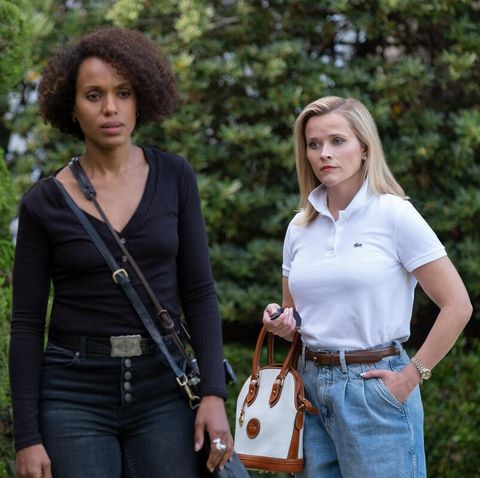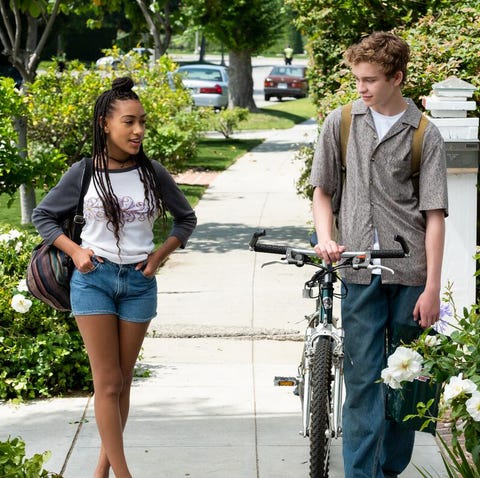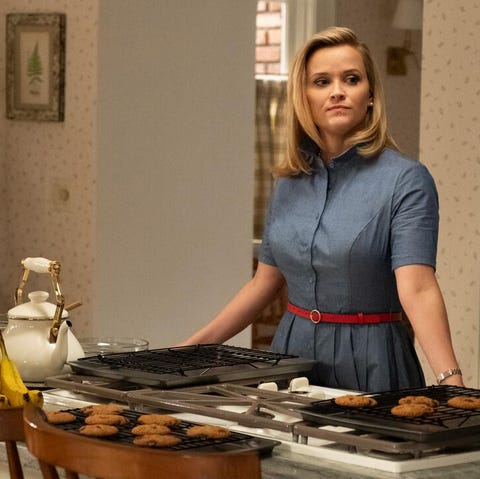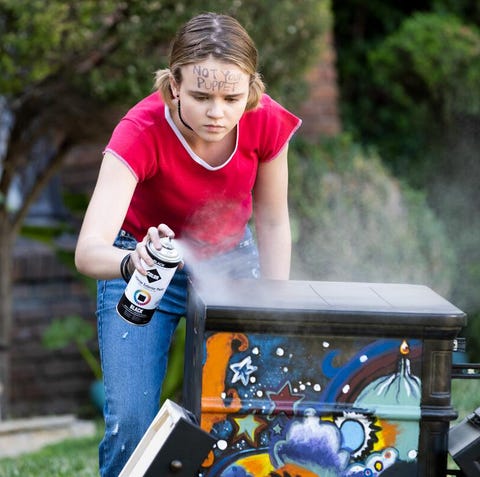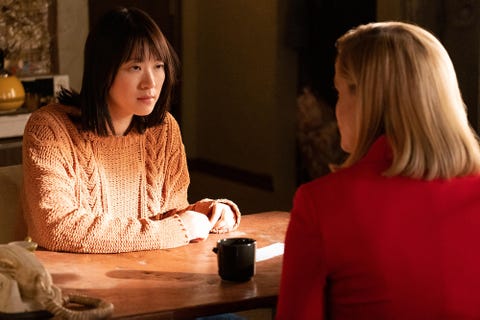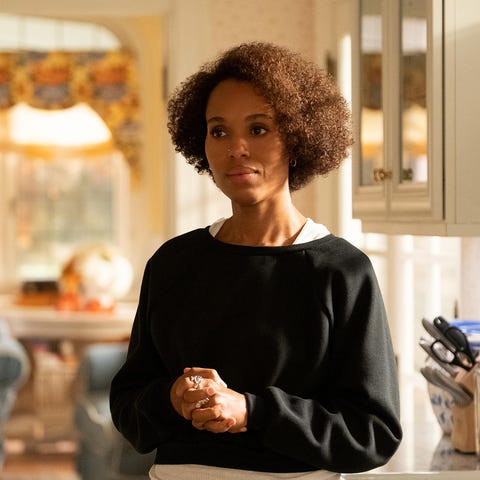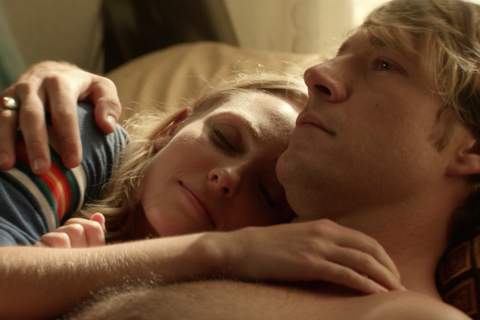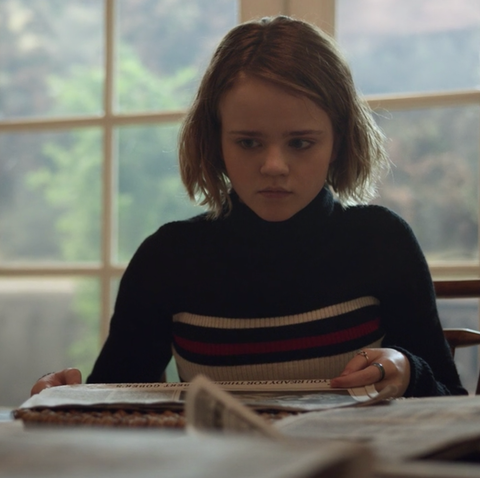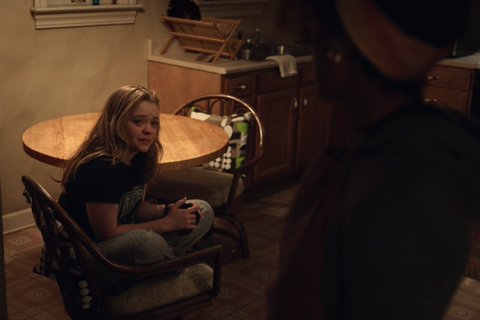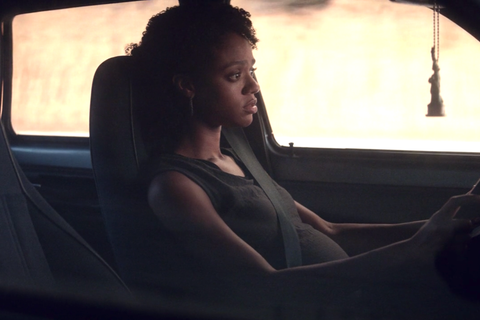Like the quaint Cleveland suburb of Shaker Heights, where Hulu’s Little Fires Everywhere takes place, everything was planned to be perfect. In 2017, the Celeste Ng book seemed invincible. The number one New York Times bestseller landed on nearly every best-of-the-year book list, and Reese Witherspoon, an early champion of the novel, gave it her Midas touch: a coveted Reese’s Book Club sticker the month it came out. Then her famed production company, Hello Sunshine, teamed up with Kerry Washington’s Simpson Street to option the book for TV. The show is now on Hulu, with Ng serving as producer. So why isn’t it a masterpiece?
Little Fires follows two polar-opposite mothers, Elena Richardson (Witherspoon, in her element as a wealthy type-A blonde) and Mia Warren (Washington, using her ferocity à la Olivia Pope to breathe complexity into a starving artist). It’s the summer of 1997, and Mia, with her daughter Pearl in tow, has just arrived in picturesque Shaker Heights, where the duplexes conceal their secondary front doors to avoid damaging curb appeal. Mia has raised Pearl mostly from the backseat of her car, but decides to settle in the suburb to work on her next project. Elena, an overachieving mother of four high schoolers, considers renting to Mia an act of charity. The two women might become friends—or at least planets in the same orbit—until Mia meets Bebe Chow. Bebe’s predicament as an undocumented immigrant who gave up her child out of desperation sharpens the contrasts between Elena and Mia until their collective secrets set their lives ablaze.
The show is compulsively bingeable, a firestorm of star power and mystery sprinkled with insightful performances that propel you into the next episode. But, as many critics have already noted, the adaptation never quite rises to the power of its predecessor—in many cases because it scrambles and alters its source material in diminishing ways. Below, ELLE.com breaks down how the series diverges from the book, episode by episode, and what those changes mean for Ng’s original story.
(Spoilers for Little Fires Everywhere below. Updates will be added weekly after each episode is released.)
Episode 1: “The Spark”
The Warrens Are Discovered, Not Introduced
In the harried first moments of the premiere, little seems different from the book. We watch how the story ends: Elena Richardson stares at the crumbling remains of her home, burning to embers.
But as the show flashes back to four months prior, it continues Elena’s story. She starts her day checking her weight and preparing her husband’s coffee before work. Bright and enthusiastic, she’s the ideal suburban mother. A normal day awaits her, until she drives past a car in a parking lot, where she sees a woman sleeping. Elena calls the police to investigate.
And so we meet Mia and Pearl Warren (Lexi Underwood), but their introduction in the book is much different. Though chapter one opens with the Richardsons watching their house burn, chapter two introduces the Warrens merely as recent Shaker transplants. There’s little about them that raises Elena’s perfectly plucked eyebrows. The show, instead, introduces them through Elena’s suspicious gaze: as a problem, an unsightly blemish on her otherwise spotless neighborhood. When they want to rent from her, she agrees partly out of guilt. This stigma sticks to them throughout the series.
The Warrens Are Black
Immediately, the show introduces a crucial change from the source material: Mia is black. In Ng’s novel, Mia’s race is never explicitly mentioned, though we are to assume she is white; the class division between her and the rest of Shaker is stark, sure, but we know her life would look markedly different if she was black. This is what Hulu’s adaptation explores, and race changes how Mia’s every action is perceived, from dozing in her car to shopping for groceries in a mostly-white neighborhood. This is an excellent choice for the adaptation, as it adds another layer of nuance to Mia and Elena’s coming conflict.
Unfortunately, the show doesn’t always handle this conversation artfully. It’s set in the ‘90s, when “colorblind” politics were all the rage, and Elena takes every chance she can to reference this. When the Warrens first arrive to peruse the Richardsons’ rental, Elena mentions their school: “It was actually one of the first integrated schools in the city!” Many awkward remarks that equate with, “Look at me, being colorblind,” stack up in the two episodes that follow. They plant the initial seed for what could have become a captivating dissection of privilege, but instead, the characters continue to skirt the issue. The comments make the characters seem stubbornly two-dimensional, and they never lead to any honest insight. Hopefully this changes in the episodes to come.
Izzy Suffers From More Than Teen Angst
When Pearl meets Moody (Gavin Lewis), the Richardsons’ sophomore son, we get a closer peek at Elena’s relationship with her youngest daughter, Izzy. They’re not close.
In the book, Izzy is painted as a somewhat archetypal black sheep. She doesn’t like the cookie-cutter life her mother sketched out for her. She responds by arguing, acting out, and pulling pranks on teachers who mistreat her few friends. But the show adds another layer: One of Izzy’s recent friendships has ruptured, and Elena doesn’t know why. She suggests Izzy wear her hair down in an effort to boost her daughter’s popularity. Simple enough, right? But Izzy, in protest, sets her hair on fire.
This is, uh, perhaps a little heavy-handed. Setting up Izzy as a pyromaniac in the first episode gives us little reason to doubt she might be to blame for the subsequent house-on-fire incident. And yet her parents refuse therapy?? Instead, Elena suggests Izzy get “The Rachel.” How we love the ’90s.
Moody and Pearl Are Caught Trespassing
As Moody and Pearl’s relationship deepens, he invites her to his makeshift hideout in a local junkyard. They recite brooding poetry and exchange coy looks…until neighborhood watch discovers them.
Mia, terrified to see a police car pulling up to her driveway, loses it. Elena, who is noticeably calmer—and, in fact, is friends with the neighborhood watchman—tells Mia there’s “no reason to get this upset.” This doesn’t soothe Mia. Later, she tells Pearl, black people “don’t get passes like them.” In response, Pearl lashes out, telling Mia, “Mrs. Richardson puts her kids first,” implying Mia does not.
None of this snapping back and forth takes place in the book. The subtext is there, of course: Pearl wishes for stability, for clarity around her history, for the cozy but inaccessible world of the Richardsons. But by cracking open these wounds with a shouting match, the show erases the book’s more detailed examination of class tension, of empathy and lack thereof. We are encouraged, instead, to pick a side and join the fray.
Episode 2: “Seeds and All”
Mia Has Sex
From the moment the second episode begins, we know exactly what kind of creaking noise we’re hearing. Mia’s having sex with a stranger in her car while Pearl sleeps in the backseat. The show’s treatment of Mia’s sexuality is an enormous shift from Ng’s novel. In the book, Mia is pointedly asexual. She’s never seen an adult man naked. She’s never, as Ng puts it, “felt that warmth, that electric tension.” Yet in the Hulu adaptation, Pearl tells Moody her mother has sex with “whomever she wants, whenever she wants.” Mia tells Pearl sex doesn’t need to mean anything.
This contrasts with Elena, who, comically, schedules sex with her husband for every Wednesday and Saturday. But why such a stark division between the two women? To demonstrate Elena as the overcautious architect and Mia as the careless free spirit? That’s already established. Giving Mia a trait with more mystery, more nuance, more collision against a world that doesn’t understand her—that would have been the bolder choice.
Pearl and Moody Hint At Something More
We knew this would happen. In the book, Moody has a sizable, obvious crush on Pearl, but Pearl never gives him a reason to believe she feels the same. In the show’s second episode, however, the two enjoy some of Mia’s weed stash—another interesting deviation from the book—and collapse on the bed together. They intertwine hands. They talk about sex. The audience starts to wonder.
Mia Rescues Book Club
Much to her chagrin, Elena is tasked with hosting a discussion of The Vagina Monologues for book club. (She unsurprisingly hates the word “vagina” and wanted to read something less controversial, like *cough* Memoirs of A Geisha). The gossip takes a turn as some of the attendees express similar discomfort, while others want to explore the stigma. Mia, who is helping with food and drink, decides to step in.
Only a few hours earlier, Mia stumbled upon a criminal background check of her own name, faxed to Elena’s home office. Now, she jumps in to rescue Elena’s floundering argument at the club, telling the group, “I think Elena is talking about vaginas as a metaphor for our own discomfort with the parts of us that make us most uniquely and primarily who we are.” None of this happens in the book.
Afterward, Elena and Mia share a bottle of wine. They discuss the fax. They discuss motherhood. They giggle and get a little drunk. They inch closer to each other, but then Elena offers to buy Mia’s art. Mia pulls back. The two women never circle each other this closely in the book. Their relationship is more distant and uncomfortable—intersecting but not meshed.
Pearl Leans On Elena’s Leverage
Pearl sits down with a guidance counselor to advocate for a position in a more challenging math course. The man takes one look at her and assumes three things: 1) She’s commuting from Cleveland, 2) The classes would be too tough for her, and 3) She needs subsidized lunch forms. Only the last is true.
Frustrated, Pearl confides in her mother, who tells her she’s a smart girl who can figure it out. Discouraged, Pearl asks Elena for help drafting a letter to the counselor. Elena says she’ll handle it, and goes to the school to make the change herself. When Mia asks about it later, Pearl says she took care of it. But in the book, she makes a point only to omit information when talking to her mother—never outright lying. It’s a trademark of her character and of the mother-daughter relationship. Even in all the chaos, Pearl remains bound to Mia. In the show, she’s already slipping away.
Episode 3: “Seventy Cents”
Mia Pushes Bebe Chow To Find Her Daughter
In the third episode, we’re finally introduced to the main conflict of the novel: Bebe Chow’s legitimacy as a mother. We watch as Bebe (Huang Lu), newborn May Ling in her arms, struggles to get her daughter to latch. An undocumented Chinese immigrant, Bebe has no resources. She has no money for formula. Her lighting and heat is shut off. She does not sleep, and May Ling does not stop crying. Desperate, she leaves the baby at a fire station, where she hopes someone will care for the child until she can.
But the baby disappears. Now working at a Chinese restaurant, Lucky Palace, with Mia, Bebe tells her story. Mia, suddenly lit from within, pushes her co-worker to search for her daughter. There’s an urgency in her tone that doesn’t quite match Mia’s careful, quiet nature in the book. We know immediately that Mia has a stake in this.
Lexie Steals Pearl’s Essay
Lexie (Jade Pettyjohn), Elena’s eldest daughter, will get into Yale. She will. There is no question. But in order to do so, she has to write an essay about a “hardship” she’s endured. Worried her glittering, conflict-free life won’t cut it, Lexie decides to use Pearl’s story—remember the counselor?—as her own, substituting gender discrimination for racial prejudice. She feels justified because, later, she takes Pearl dress shopping.
Lexie reads her modified essay aloud to her boyfriend, Brian, who is black. He’s doubtful Lexie actually experienced this trauma, and later, he learns the truth: Lexie’s essay wasn’t “inspired” by anything. It was taken from Pearl and transformed for Lexie’s benefit. He tells Pearl the truth at the school dance. In the book, Pearl offers to write Lexie’s essay for her, but the show doesn’t give her the chance to make that decision.
Izzy Is Targeted for Her Sexuality at School
At dinner, Trip refers to Izzy as “Ellen.” Her face freezes, and she leaves the table. When Elena expresses confusion, Moody explains, “Like Degeneres, Mom.” Elena confronts her daughter about this later, on the way to school. She tells Izzy, “If they’re saying something untrue, then you should change the story.” She wavers. “Are they saying something untrue?”
“Of course it’s untrue,” Izzy snaps.
In the book, Izzy’s sexuality is never explored. Her status as a social pariah has less to do with her orientation than with the singled-out attention her mother bestowed on her from early childhood. The show’s inclusion of another complicated social construct—heteronormativity—is an interesting and admirable one, but the piling of conflict over conflict, identity over identity, starts to rub away at the core of the characters until they’re better defined as archetypes.
Later in this episode, Izzy is accused of sexually assaulting a female classmate.
Bebe Crashes Her Daughter’s Birthday Party
When Elena lets it slip to Mia that her best friend, Linda McCullough, recently adopted a Chinese baby who was found abandoned at a fire station, Mia nearly trips over herself to get out the door. Later, she offers to photograph the baby’s birthday party, and when she discovers a distinctive birthmark on the back of her head, rushes to tell Bebe.
Against Mia’s advice, Bebe insists on seeing May Ling (now Mirabelle) immediately, and rushes to the party. As Elena brings in the cake with a single fluttering candle, Bebe bursts through the front door, screaming, “That’s my baby!” The party devolves into hysterical shouting, and two guests drag Bebe out of the house. This does not happen in the book. The chaos makes for great television and a hell of a cliffhanger for the first three episodes. But there’s also something off about this scene. It makes Bebe seem deranged, unjustified rather than simply unwelcome. Once again, nuance is cut out of the story in favor of melodrama. Ng’s work thrives on subtlety, on what’s understood but unsaid. There’s nothing subtle about this.
Episode 4: “The Spider Web”
Elena offers Bebe money to leave the McCulloughs alone.
Elena, ever the journalist, realizes Mia was involved with Bebe’s sudden appearance at the birthday party when she recognizes the description of Mia’s hatchback in the police report. After placing an order at Lucky Palace, she confirms her own suspicions: Bebe and Mia work together, and Mia is helping Bebe fight for her baby.
Seemingly desperate to assist her spiraling friend Linda—when, in reality, she simply can’t stand not to be in the center of the action—Elena offers to negotiate with Bebe on the McCulloughs’ behalf. She shows up at Bebe’s apartment with a $10,000 check and her signature condescending tone, sweetened just enough to make you question her intentions. She tells Bebe to take the money and give her daughter “a better life.” She even throws in a bonus: She’ll help Bebe gain legal citizenship. Bebe responds, “You have children?” When Elena answers affirmatively, Bebe lands a razor-sharp retort: “How much would you sell them for?”
This never happens in the book. First of all, $10,000 is quite a lowball, even when adjusted for inflation—adopting a baby can cost around $45,000, sometimes much more. Buying a baby off her mother for quite a bit lower seems both unrealistic and cruel.
Second, this is another example of the writers taking Elena’s character a step further than necessary. In the book, Elena makes her decisions carefully. She believes “passion, like fire, [is] a dangerous thing.” She’d be smart enough to know that offering a woman money for her child won’t look good in court, and she’d find a more subtle (and passive aggressive) way to fight.
Mia sells her prized photo to get Bebe money for a lawyer.
In the book, this decision isn’t necessary. Ed Lim, Bebe’s lawyer, decides to represent her, gratis, after seeing segments about her in the news. Mia and Bebe cleverly launch this media campaign to get the edge on the McCulloughs.
In the show, Mia is more desperate. Bebe needs $30,000 for a lawyer, and in order to get it, Mia contacts her gallerist, Anita, and sells her most prized work: a photograph of Mia herself, pregnant with Pearl and naked in a bathtub. She sobs as she packages it and sends it to Sotheby’s.
This photo does not exist in the book, though it’s probably meant to stand in for another. We’ll get into that in later episodes.
Pearl and Trip have an, uh, uncomfortable encounter.
Pearl and Trip do indeed have a romance in the book, but in the show it goes wrong before it can begin. While studying together, they begin to make out. They head to Pearl’s bed and start to have sex, but Trip finds he’s struggling to, well, keep it up. In response, he jumps up quickly, pissed, and pulls on his clothes. He blames Pearl for “doing it wrong” and accuses her of manipulating both him and Moody into falling for her. Trip, in essence, comes out looking like an enormous jerk.
This scene never happens in Ng’s novel. In fact, the relationship and sex between Pearl and Trip is good and healthy. Th show’s narrative decision cuts off Trip’s pathway to character growth. In the book, his relationship with Pearl allows him to become much more complex than the jerk jock he seems to be. In the show, that’s exactly what he is.
Elena and Mia have a blowout fight.
Drama, drama, drama, friends. I’ve got to give Witherspoon and Washington props for this scene. It is an adventure to watch. Although, of course, it never happens in the book.
After Elena confirms that Bebe and Mia are in cahoots, she turns on Mia rather violently while Mia scrubs her kitchen. She tells her tenant, “You’re manipulative and deceitful with no sense of the rules or consequences, like your friend Bebe…You’re both terrible mothers…A good mother makes good choices.”
Mia whirls around with a spectacular comeback: “You didn’t make good choices; you had good choices. Options that being rich and white and entitled gave you.”
Elena: “Again, that’s the difference between you and me. I would never make this about race.”
Mia: “Elena, you made this about race when you stood out there on the street and begged me to be your maid.”
This makes for excellent television, and you already know that. I will happily watch Witherspoon and Washington duke it out anytime, and that line about choices from Mia might be one of my favorite in the series so far. But then the conversation continues, spelling out the conflict letter by letter.
Listen, this relationship has always been about race. It was about race from the moment Elena called the police and reported an “African-American” woman sleeping in her car. The audience already knows the conflict is about race. The book is able to depict a class divide artfully; the show, while wonderfully ambitious and well-acted, rarely lets what’s unsaid speak for itself. And so we are not allowed to think carefully and constructively about how this divide happened. Instead, we see only the carnage.
Mia steals…a lot of things.
We witness Mia taking receipts, measuring cups, prescription pills, stockings, and more from the Richardson house. She later burns a photo of Elena. None of this happens in the book, and I’ll be honest: I have no idea why it happens in the show.
Episode 5: “Duo”
We meet a young Elena.
Elena is an enigma wrapped in ribbons. In Celeste Ng’s novel, we don’t learn much about her interior desires or regrets —because she doesn’t allow herself to acknowledge them. Instead, we get tiny pieces of her history: She grew up watching the chaos of the ’60s on television and, Ng writes, “Deep inside her a spark kindled, a spark that would flare in Izzy years later …But part of her shuddered at the scenes on the television screen.”
We also learn she had a boyfriend, Jamie Reynolds. He invites her to run away to California with him, and she’s tempted to go, but pragmatism keep her in Shaker Heights. “She’d been crazy to have considered it even for a moment,” Ng writes. “What she had felt for Jamie back then had been just a tiny, passing flame.”
Jamie is later drafted in the Vietnam War, and the reader assumes he didn’t survive. That’s all know. But the show makes an interesting—and I think wise—choice to bring Elena’s past into the spotlight. We see her in Paris, bright and bubbly and sensuous, in love with Jamie. But this Jamie is not a hippie; he’s a budding journalist who wants to explore the world. He tells her he can’t go back to Ohio.
She responds, “Jamie, we have a whole plan”: Move into her parents’ rental. Get jobs at the Shaker Times. Build a nuclear family.
He can’t live with the possibility of regret. They break up. Though this takes place differently in the book, the show gives us deeper insight into Elena’s history and the sacrifices she’s too terrified to make.
Izzy finds Mia’s photo in the New York Times and it causes a rift between them.
Remember that photo of a pregnant Mia, the one she sent to Sotheby’s to get money for Bebe’s lawyer? Well, Izzy saw the Sotheby’s package before it shipped from Mia’s rental. And then she sees the photo printed in the New York Times—and has the remarkably dumb notion to tell her mother.
Apparently, the photo is famous enough to warrant an enormous payout and coverage in the Times‘ art section. This isn’t quite the case in the book, where a photo of Mia holding an infant Pearl is featured at a local art museum, and the children (including Izzy) see it on a class field trip. Apparently, it was shot by the late, world-famous photographer Pauline Hawthorne.
The show deserves credit here: The likelihood that Pauline’s photo would appear in a random museum in Ohio, where Mia just so happens to have recently moved, seems a little too convenient for an otherwise realistic story. But the show also suffers from a lack of realism; when Mia hears about the story in the Times, she hisses to her gallerist on the phone, “You promised no press.” But of course there would be press! It’s an incredibly famous photo appearing out of literally nowhere!
Mia, angry that Izzy saw the package (even though, uh, it was literally leaning against the wall while Izzy worked in Mia’s study), sends Izzy away. As much as this reaction was overdramatic, I appreciated Mia’s trepidation. In the book, she doesn’t always seem afraid of who knows her or who might be tracking her. We’ll soon learn why that fear is so necessary.
Lexie takes advantage of Pearl and Mia bites back.
I was curious about how Hulu would handle Lexie’s onscreen abortion, and I think they did a powerful job. In the book, Lexie gets pregnant and makes the same decision, and she does use Pearl’s name on the admission slip—but Pearl begrudgingly agrees to it. In the show, Pearl is taken aback by this decision—she isn’t given a choice and she feels betrayed.
Mia is kind until she learns that Lexie used Pearl’s name.
Lexie asks Mia, “Do you think I did the wrong thing?”
Mia: “I think my daughter skipped school to help you, and you thanked her by using her name and then demanding that she take care of you. I spent two months cooking your dinners, working in your house. You never so much as uttered a ‘thank you.’ And now you want more. Pearl may love to give and give to you, but I do not. I’m done.”
Lexie: “I’m sorry. I didn’t have anywhere else to go.”
Mia: “You had plenty of places to go and plenty of people who care. You have no concept of what it’s like to not have anyone. Don’t insult your own intelligence by pretending otherwise. When you’re done, wash out your own mug. For once.”
There’s no question that Lexie is entitled and privileged and, quite frankly, the worst. But Mia’s returned cruelty seems disingenuous, especially considering the trauma Lexie has just endured. In the book, Mia treats Lexie with a gentle, piercing wisdom—a wisdom that teaches Lexie far more than Mia’s reaction on the show. In the book, Mia says, “Oh, Lexie. You were in a very hard situation. A situation no one wants to be in…You’ll always be sad about this. But it doesn’t mean you made the wrong choice. It’s just something that you have to carry.”
In response, Lexie finds herself wondering what it would have been like to have Mia as a mother. This empathy reaches her. It changes her. In the show, I struggle to see that happening, no matter how justified Mia’s anger is.
Elena rekindles an old flame.
This episode wins an A+ from me purely on its use of Alanis Morisette’s classic “Uninvited,” but Elena’s reconnection with Jamie knocks a few points off the tally. Book Elena would’ve never let this happen.
In the book, we know Jamie disappears into the frontlines of the Vietnam War. But Hulu plants him back in Elena’s life when she goes to New York to dig into Mia’s past. She decides Jamie’s New York Times resources can help with research. But then they drink an entire bottle of champagne over dinner and have an embarrassingly rom com-like argument on the streets of Manhattan.
She says she wants to be friends with him again, then admits, “I wanted to know what your life looks like. If you were happy with the life you chose.” She admits she has regrets.
Then she asks him to go back to her hotel with her. He snaps, “What’s it like being this much of a narcissist? You stuck to your plan. It’s not my job to make your life bearable.”
This last line is intriguing. We get a peek into Elena’s desires and her regrets. But book Elena would never admit she has regrets. That’s why she can’t stand Mia. Mia’s freedom, her “irresponsibility,” jeopardizes all the principles Elena has built her life on. So Mia must be erased.
Episode 6: “The Uncanny”
Mia’s relationship with Pauline Hawthorne goes beyond friendship.
Celeste Ng’s novel devotes a hefty section to cataloguing Mia’s backstory, including how she got pregnant with a baby that, in her mother’s words, is “not hers.” But what makes episode 6, “The Uncanny,” such an interesting character study is how it uses two new actresses—Tiffany Boone as Young Mia and AnnaSophia Robb as Young Elena—to reinvent their origin stories.
Young Mia is a tender soul who’s not quite sure of herself, though Boone’s raw performance hints at the older Mia threatening to explode inside her. We see flashes of this when she whirls around to wield pepper spray in the face of a pursuer (Jesse Williams), and later, in her relationship with Pauline Hawthorne (Anika Noni Rose).
In the book, Mia and her art teacher, the famous photographer Pauline, no doubt share a close friendship. Mia regularly stays at the home of Pauline and her same-sex partner, Mal, and she becomes their apprentice of sorts. But Pauline only ever has eyes for Mal, and she and Mia never tip-toe around the line between student and teacher. The show shatters that line completely.
In “The Uncanny,” they do drugs together (not in the book), take baths together (not in the book), and have dinner with Mia’s brother (not in the book). Mia’s first sexual experience is with Pauline—in the dark room, no less—and the two fall in love. But then Mia flees New York with her unborn child following her brother’s death, telling Pauline she needs time away. Then, without warning, Pauline dies of ovarian cancer.
Pauline does indeed die in the novel, but after Mia returns with an infant Pearl and Pauline photographs them together. She later sends the images to Mia to sell for extra cash when she’s running dry. In the show, Mia only has the one large portrait of herself that she sold in episode 4.
The showrunners’ choice to make Mia bisexual and turn her mentor into a lover is a fascinating one. I’m not entirely sure it was a necessary change, though it does provide a more concrete foundation for Mia’s vacillating personality: cold and hardened from loss in one moment; gentle and passionate from the love she’s known in the next.
Young Elena does not want a fourth baby.
This is one of the most significant divergences from the novel, as it essentially erases and replaces one of the core components of Elena’s personality. Here, we get a delightful performance from AnnaSophia Robb as a bright-eyed and bushy-tailed Young Elena, who is finally, finally getting back to work after months of maternity leave with Moody. But then her doctor tells her she’s pregnant. Again. Her response is a lost, sort of breathless, “No.”
She considers an abortion. She wants an abortion. It’s a choice she’s apparently advocated for other women to make. But her mother reminds Elena that it’s not something “people like us” do. So Elena has Izzy, and chaos ensues.
This episode gives us the gift of Robb’s plate-smashing scene, in which the cacophony of her screaming children drives her to her throw wedding china on the floor. She lets out a single, guttural howl of anger. It’s incredible, and there’s no question of its relatability. We’ve seen this story so many times; motherhood is a joy, but it’s also a burden. Elena’s choice is one many women make and would make again in a heartbeat. But others want to choose differently and aren’t sure they can.
The problem here is the episode insinuates that Elena’s disdain for Izzy is somehow rooted in the fact that Izzy was unwanted. She’s the reason Elena does not have the career (and, by extension, the life) she dreamed of. In the book, Elena can’t imagine wanting anything other than her nuclear family. She’s terrified of anything that suggests otherwise. Ng writes that Elena “was usually annoyed with Izzy for some reason or another…It was not—as Izzy herself suspected, and as Lexie, in moments of meanness, teased her—because she had been an accident, or unwanted. In fact, it was quite the opposite.” And then, many chapters later, we read: “Everything that had infuriated [Elena] about Izzy, even before she’d taken her first breath, had been rooted in that one fear, that she might lose her.”
So then, who is Elena? Is she the woman who made a choice and now regrets it? That’s the show’s Elena. Or is she the woman who is terrified by the idea that any other choice was possible? That’s the book’s Elena.
Young Elena reconnects with Jamie.
We see more of this divergence in Young Elena’s relationship with former flame Jamie. Years before she reconnects with him to learn more about Mia, she drives off in the middle of the night to find him.
She calls Jamie, meets him in a bar, they talk, they dance, and they begin to kiss. They head back to a motel room and begin to take their clothes off. But when Elena goes to the bathroom and stares at herself in the mirror, when she can’t express her milk into the sink, she falls apart. She returns to Jamie, tells him she has a life and family to return to, and chastises him for taking advantage of her in this state. He’s infuriated by the insinuation.
Then she returns home. She made a choice she might regret, but at least it’s a life she has some control over.
None of this happens in the book. Jamie is nothing but a flickering memory in Elena’s mind because she would never consider regretting their break-up. It’s not an option. The idea of a different choice is foreign to her. She can’t fathom a life like Mia’s, a life with anything less than endless resources tightly monitored and maintained.
Neither Elena is less interesting than the other, but they are different characters, and it’s important for the audience to see it.
Next episode, we inch nearer to the final straw: The conflict that sets the Richardson home ablaze.
